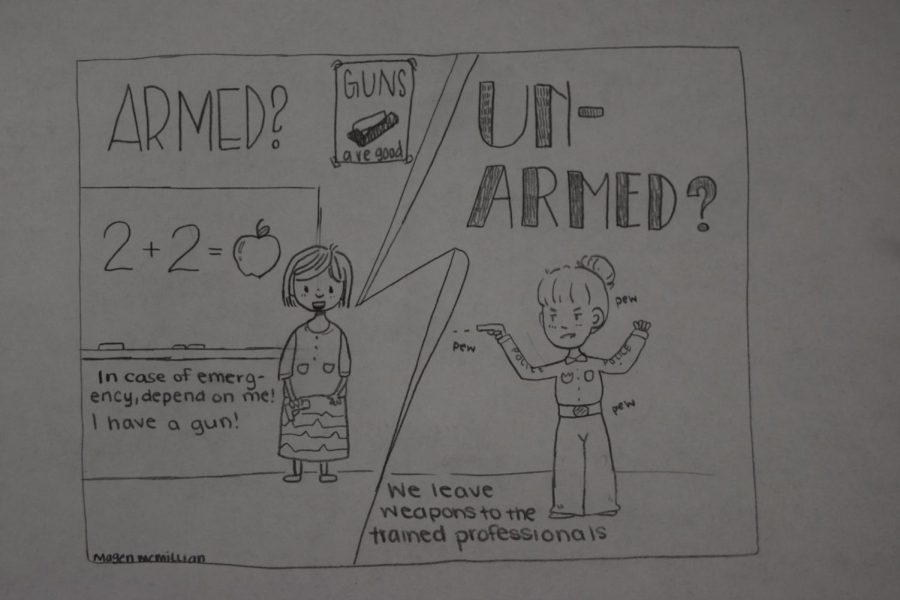Contradicting Opinions Arise
Teachers armed in the classroom
October 19, 2018
Six years ago, Adam Lanza took his mother’s guns and entered Sandy Hook Elementary school, killing twenty six children and staff within eleven minutes. As of June 28, 2018, 154 schools experienced school shooting incidents (starting the second semester of the school year). Since 2013, an average of 442 incidents occurred across the United States. Some politicians say giving teachers firearms solves the problem, but several teachers say otherwise.
“I don’t think it is necessary to ‘arm’ teachers in a school setting in a way that would require teachers to serve as a de facto SWAT team when our focus should be on education. However, I don’t think it is right, smart, or moral to disarm teachers either (which is the current policy at Decatur ISD),” geography teacher Jacob Belding said. “If a teacher, administrator or other school employee has a CHL (concealed handgun license) or LTC (license to carry), it is unethical to take away their right to self defense just because they’ve entered their place of employment where they work, especially because of how schools seem to be favorite targets of criminals due to the fact people are disarmed in these ‘gun-free’ areas,” Belding said.
Some teachers go against the idea of arming guns because of the statistics behind gun violence.
“Historically, the presence of guns at the scene of a massive shooting has done little to deter violence. Put simply, the answer to deter gun violence is not more guns. Consider that in the previous 10 years, the United States has experienced an estimated 288 school shootings. The country with the next highest instances of school shootings during that same time period is Mexico with 8,” history teacher Christopher Chance said. “Included in that same study are Australia, Japan and Switzerland with zero incidents of school violence. So why the discrepancy? Because we try to treat the symptom and not the problem. At its source, mass shootings in our schools can be attributed to two main issues, mental illness, and the lack of comprehensive bipartisan gun reform.”
Mexico, Australia, Japan and Switzerland all keep strict gun laws. In Mexico, certain guns remain restricted to the military. In Japan, people submit a lengthy form to own a gun. The majority of people in America own a gun, or know someone who owns one. America also holds the 11th place on the list of most firearm related deaths. More than ten percent of the population dies from a firearm every year.
However, some teachers agree that keeping a few teachers armed seems beneficial.
“Arming teachers is a current controversial topic and I understand both sides of the argument. I personally do not want a gun in my classroom, however, I am not against having properly trained teachers armed during school hours,” history teacher Cherie Hocevar said. “If there is armed faculty on campus, it could prevent unnecessary schoolwide tragedy or stop an attacker. It could also possibly create a sense of security for students (and faculty) knowing that there is extra protection on campus. Although I am for arming teachers, I think there are other security measures the district could implement before jumping straight into arming teachers.”
“I have mixed feelings about giving teachers guns,” math teacher Jenna Barthold said. “I feel that it could be a great way to provide more safety for a school, but then again as a teacher I would not personally want to be the one responsible for keeping a gun and possibly having to use it. The side of me that is for it thinks it would be great and I believe could make an intruder think twice about what they might do if they know there could be multiple guns around the school who could easily stop or kill them before they ever have a chance to do what they had planned.”
In 1996, Australia experienced a large massacre: it left 35 people dead and 23 wounded. After this, Australia outlawed guns. In the 21 years since, zero shootings occured. Japan outlaws many types of guns, so almost no one accidentally gets their hands on them.
“The one thing that all the countries listed above have in common, is that at one point they all experienced an episode of gun violence,” Chance said. “The difference is, the leaders in those countries worked together to achieve objective, common-sense reform rather than politicizing violence. What should that reform look like? I have no idea, and I would rather not stick my toe in that political hotbed, but I do know that arming teachers is not the answer.”




